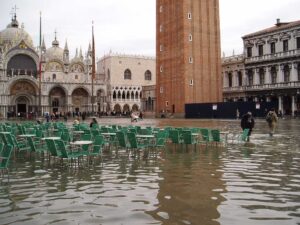Tag: Bursting the PC Bubble
Bursting the PC Bubble: Flooding in Venice Causes Panic
by The Cowl Editor on November 21, 2019
National and Global News

by Maura Campbell
News Staff
On Tuesday, November 12, Venice was flooded by the most severe high tide the city has seen since 1966. The flood lasted for several days and left profound impacts. At its peak, the flood reached six foot high tides, and covered 85 percent of the city’s streets.
One of the areas most devastated by the flooding was St. Mark’s Basilica, one of the world’s most famous cathedrals. This flooding has prompted global concerns for the fate of such cultural icons against the effects of climate change.
Luigi Brugnaro, mayor of Venice, declared a state of emergency, stating that the Basilica has suffered “grave damage.” Similarly, Prime Minister of Italy Giuseppe Conte called the damage “a blow to the art of our country.”
Although many artifacts were spared from the damage due to their storage high above the ground, countless other artifacts throughout the city have been damaged or destroyed.
St. Mark’s Basilica, which was built in the ninth century, has only flooded six times since its construction. Architectural and cultural experts are widely concerned about the future of this building, particularly since it houses so many important cultural artifacts, including paintings, texts, and historical and religious artifacts.
In addition, the integrity of the structure itself has been called into question. Salvo Nastasi, secretary general of Italy’s Ministry of Cultural Heritage and Activities and Tourism, said, “The situation is extremely complex and worrisome, not just for the water level, but also the number of hours the precious marble floorings and wooden coatings of the Basilica have been submerged.”
St. Mark’s Basilica is not the only building affected by the flood. Churches, museums, houses, monuments, and hotels have also been irreparably damaged throughout the city. However, it will be impossible to fully assess the damage until the water has completely subsided.
Officials have already begun the process of pumping saltwater out of structures. “The main issue is saltwater,” Toto Bergamo Rossi, the director of Venetian Heritage, says. “When salt permeates the materials of these buildings—be them marble, tiling, plaster or wood—it crystallizes and ascends vertically once the weather gets drier, from the ground to the first floor and so on. It’s almost like a cancer for these structures, all the more so when they are so old. The entire wall system can be affected.”
Venice is in particular danger of succumbing to the threats of climate change due to its location and low sea level. Over the past several years, countless smaller floods have submerged St. Mark’s Square and residents have been forced to adapt to the changing landscape.
The city of Venice has spent billions of euro to construct a flood barrier system in order to prevent disasters like this. This system, called MOSE, has been delayed several times; originally intended to be finished in 2011, the project has been delayed until 2022 and is still not expected to be finished oby the deadline.
“The MOSE has to be completed,” Rossi says. “Not in two years, but over the next months. Buildings, too, have to be guaranteed a better draining system, maintenance, material reinforcement. This could easily happen again, and we simply can’t afford that. There’s too much at risk.”
Even if the MOSE system is completed and becomes operational, many climate experts believe that it is not a permanent solution to the city’s constant threat of flooding. In fact, recent studies have shown that climate change could push Venice entirely underwater within a century.
World News Briefs: Division in D.C.
by The Cowl Editor on January 27, 2017
News

by Meaghan Dodson ’17 and Tait Becker ’19
News Staff
Presidential Inauguration
Donald Trump was officially sworn in as the 45th President of the United States on Friday, January 20.
The Obamas were there to greet the Trumps at the White House, with President Barack Obama stating, “Mr. President-elect, how are you? Good to see you. Congratulations.” Hillary Clinton, who lost the recent presidential election despite winning the popular vote, was also in attendance at the ceremony with her husband, former president Bill Clinton.
Trump then proceeded to the Capitol where, at noon, he officially took the oath of office and addressed the nation for the first time as the President of the United States.
A sizable crowd came to witness the swearing in, but the exact number is still being determined. White House spokesman Sean Spicer stated that the crowd was “the largest audience to ever witness an inauguration.” Others, however, observed that the crowd looked noticeably smaller than the crowd for Obama’s inauguration in 2009.
“From this day forward, a new vision will govern our land,” President Trump stated. “From this moment on, it’s going to be America first.”
Concluding his inauguration speech, he stated, “Your voice, your hopes, and your dreams will define our American destiny. And your courage and goodness and love will forever guide us along the way. Together, we will make America strong again. We will make America wealthy again. We will make America proud again. We will make America safe again. And yes, together, we will make America great again.”
Women’s March
Less than 24 hours after President Trump’s inauguration, people around the world stood in solidarity with those marching in The Women’s March in Washington, D.C. Protests occured everywhere from London to Antarctica to Sydney in an effort to demonstrate feelings of discontent after the inauguration of President Donald Trump.
Marchers walked through the streets of Washington, D.C., with signs reading, “Girls Just Wanna Have Fun-Damental Human Rights,” and “We Shall Overcomb.”
Many of the protests aimed to target issues that the marchers believe will be threatened during the Trump presidency. Ending violence against women, reproductive rights, and workplace equality were among the most prominent of these issues.
In addition to many women’s issues that were brought up, Brexit, gay and bisexual protection, and nuclear weapons were all topics of controversy for these groups of individuals.
Katy Perry, Cher, and several other celebrities were present at the march, while many others shared their support via social media. Gloria Steinem and America Ferrera, meanwhile, were just two of the event’s speakers.
President Trump responded to the march via Twitter, stating, “Watched protests yesterday but was under the impression that we just had an election! Why didn’t these people vote?”
Although the exact numbers are still being determined, some analysts suggest that the march had three times more people than President Trump’s inauguration.
